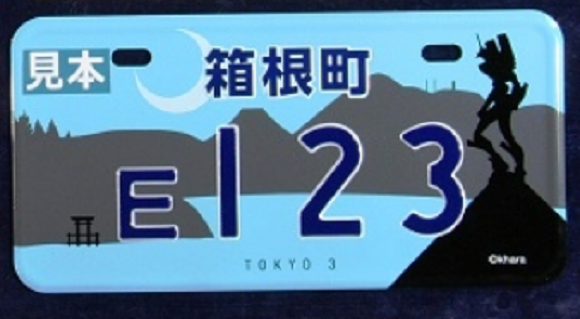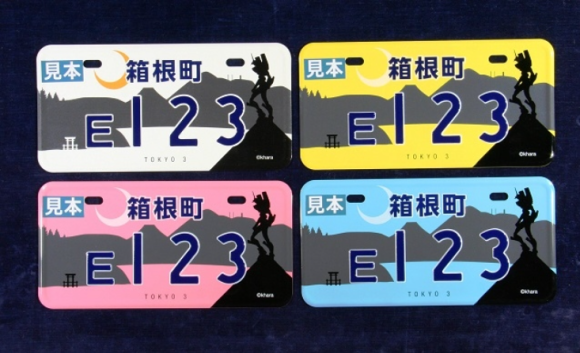
The very first time she came over to the swinging bachelor pad/pitiful bunker I used to live in back when we were dating, my wife immediately noticed that the one and only interior decoration I had was a California license plate mounted on the wall. To me, the blue on white design is immediately nostalgic and reassuring.
In Japan, though, ordinarily the only thing that differentiates plates issued in different parts of the country are the kanji characters written across their tops, so they don’t provide quite the same immediate visual shorthand of local pride. Unless you happen to live in the city of Hakone, where motorists can show their love of their hometown and giant robot anime all at once with new Evangelion license plates.
The vast majority of modern-day anime is set in Tokyo, which is understandable seeing as it’s the country’s political, financial, and entertainment capital. Still, the rest of Japan can feel a little left out once in a while.
Take Kanagawa Prefecture, Tokyo’s neighbor to the south, for example. With over nine million people, it’s the second-most populated administrative district in Japan, but rarely shows up in animated form (a few scenes in the classic Macross notwithstanding).
But while the frequency of Kanagawa’s anime appearances is undeniably low, almost the entirety of Evangelion, the biggest Japanese animation biggest hit of this generation, takes place there.
This may come as a surprise for some viewers, as while Evangelion’s dialogue is 30 percent obfuscating religious references, 30 percent complicated pseudo-science, and 30 percent rambling sexual frustration, the remaining 10 percent clearly has the characters saying they live someplace called Tokyo 3.
A closer look, though, reveals some discrepancies between Tokyo 3 and Japan’s real-life capital. There are two things present in the anime’s setting that are absent from the actual Tokyo: the numerical accoutrements and the surrounding mountains.
That topographical difference is because the location of Evangelion’s Tokyo 3 corresponds with the city of Hakone, in Kanagawa Prefecture.
Hakone is already a pretty big tourist draw, thanks to its proximity to Mt. Fuji, numerous hot springs, and beautiful fields of pampas grass, making it a popular vacation spot for families and couples. In recent years, the local tourism association has drawn in anime fans, too, by playing up the town’s connection to the anime with Evangelion-themed sightseeing maps, vending machines, and souvenir shops (plus cakes, the alpha and the omega of tourism in Japan).
Hakone’s newest Eva-inspired move, though, is for locals. Starting on March 25, owners of motorized bicycles, scooters, and microcars registered in the city can apply for Evangelion license plates.
Each of the four differently colored plates features the series’ titular giant robot in profile, with Hakone landmarks such as Hakone Shrine, Lake Ashinoko, and Mt. Fuji in the background. There’s also a crescent moon, which has no particular connection to Evangelion or Hakone, but is simply there because it looks awesome.
Availability is limited to 390 plates, but given that only 769 vehicles currently registered in Hakone fit the criteria, there should be enough to go around. Interested parties can submit their application at the Hakone Tax Bureau, which unfortunately doesn’t yet sell “My other car is unit 01” bumper stickers.
Source: Anime! Anime!
Top image: Anime! Anime!


 Things to pick up at 7-Eleven: Milk, melon bread, Evangelion sports car
Things to pick up at 7-Eleven: Milk, melon bread, Evangelion sports car Tokyo’s beautiful new license plates are based on one of Japan’s most famous woodblock paintings
Tokyo’s beautiful new license plates are based on one of Japan’s most famous woodblock paintings Take a tour of Tokyo-3 on an Evangelion bus
Take a tour of Tokyo-3 on an Evangelion bus You can get married in Japan with official, legally binding Evangelion marriage registration forms
You can get married in Japan with official, legally binding Evangelion marriage registration forms Godzilla vs. Evangelion towels need all of Japan as stage big enough to contain their awesomeness
Godzilla vs. Evangelion towels need all of Japan as stage big enough to contain their awesomeness Red light district sushi restaurant in Tokyo shows us just how wrong we were about it
Red light district sushi restaurant in Tokyo shows us just how wrong we were about it Sandwiches fit for a sumo served up in Osaka【Taste Test】
Sandwiches fit for a sumo served up in Osaka【Taste Test】 Pokémon Sleep camping suite and guestrooms coming to Tokyo Hyatt along with giant Snorlax burgers
Pokémon Sleep camping suite and guestrooms coming to Tokyo Hyatt along with giant Snorlax burgers Tokyo Tsukiji fish market site to be redeveloped with 50,000-seat stadium, hotel, shopping center
Tokyo Tsukiji fish market site to be redeveloped with 50,000-seat stadium, hotel, shopping center Japanese ramen restaurants under pressure from new yen banknotes
Japanese ramen restaurants under pressure from new yen banknotes Akihabara pop-up shop sells goods made by Japanese prison inmates
Akihabara pop-up shop sells goods made by Japanese prison inmates Anime girl English teacher Ellen-sensei becomes VTuber/VVTUber and NFT
Anime girl English teacher Ellen-sensei becomes VTuber/VVTUber and NFT Starbucks Japan adds a Motto Frappuccino to the menu for a limited time
Starbucks Japan adds a Motto Frappuccino to the menu for a limited time McDonald’s new Happy Meals offer up cute and practical Sanrio lifestyle goods
McDonald’s new Happy Meals offer up cute and practical Sanrio lifestyle goods Beautiful Red and Blue Star luxury trains set to be Japan’s new Hokkaido travel stars
Beautiful Red and Blue Star luxury trains set to be Japan’s new Hokkaido travel stars All-you-can-drink Starbucks and amazing views part of Tokyo’s new 170 meter-high sky lounge
All-you-can-drink Starbucks and amazing views part of Tokyo’s new 170 meter-high sky lounge More foreign tourists than ever before in history visited Japan last month
More foreign tourists than ever before in history visited Japan last month French Fries Bread in Tokyo’s Shibuya becomes a hit on social media
French Fries Bread in Tokyo’s Shibuya becomes a hit on social media Studio Ghibli releases new action figures featuring Nausicaä of the Valley of the Wind characters
Studio Ghibli releases new action figures featuring Nausicaä of the Valley of the Wind characters New private rooms on Tokaido Shinkansen change the way we travel from Tokyo to Kyoto
New private rooms on Tokaido Shinkansen change the way we travel from Tokyo to Kyoto Starbucks reopens at Shibuya Scramble Crossing with new look and design concept
Starbucks reopens at Shibuya Scramble Crossing with new look and design concept Studio Ghibli glasses cases let anime characters keep an eye on your spectacles
Studio Ghibli glasses cases let anime characters keep an eye on your spectacles Beautiful Ghibli sealing wax kits let you create accessories and elegant letter decorations【Pics】
Beautiful Ghibli sealing wax kits let you create accessories and elegant letter decorations【Pics】 Studio Ghibli releases Kiki’s Delivery Service chocolate cake pouches in Japan
Studio Ghibli releases Kiki’s Delivery Service chocolate cake pouches in Japan New definition of “Japanese whiskey” goes into effect to prevent fakes from fooling overseas buyers
New definition of “Japanese whiskey” goes into effect to prevent fakes from fooling overseas buyers Our Japanese reporter visits Costco in the U.S., finds super American and very Japanese things
Our Japanese reporter visits Costco in the U.S., finds super American and very Japanese things Studio Ghibli unveils Mother’s Day gift set that captures the love in My Neighbour Totoro
Studio Ghibli unveils Mother’s Day gift set that captures the love in My Neighbour Totoro New Japanese KitKat flavour stars Sanrio characters, including Hello Kitty
New Japanese KitKat flavour stars Sanrio characters, including Hello Kitty New Pokémon cakes let you eat your way through Pikachu and all the Eevee evolutions
New Pokémon cakes let you eat your way through Pikachu and all the Eevee evolutions Disney princesses get official manga makeovers for Manga Princess Cafe opening in Tokyo
Disney princesses get official manga makeovers for Manga Princess Cafe opening in Tokyo Sales of Japan’s most convenient train ticket/shopping payment cards suspended indefinitely
Sales of Japan’s most convenient train ticket/shopping payment cards suspended indefinitely Sold-out Studio Ghibli desktop humidifiers are back so Totoro can help you through the dry season
Sold-out Studio Ghibli desktop humidifiers are back so Totoro can help you through the dry season Japanese government to make first change to romanization spelling rules since the 1950s
Japanese government to make first change to romanization spelling rules since the 1950s Ghibli founders Toshio Suzuki and Hayao Miyazaki contribute to Japanese whisky Totoro label design
Ghibli founders Toshio Suzuki and Hayao Miyazaki contribute to Japanese whisky Totoro label design Doraemon found buried at sea as scene from 1993 anime becomes real life【Photos】
Doraemon found buried at sea as scene from 1993 anime becomes real life【Photos】 Tokyo’s most famous Starbucks is closed
Tokyo’s most famous Starbucks is closed One Piece characters’ nationalities revealed, but fans have mixed opinions
One Piece characters’ nationalities revealed, but fans have mixed opinions We asked a Uniqlo employee what four things we should buy and their suggestions didn’t disappoint
We asked a Uniqlo employee what four things we should buy and their suggestions didn’t disappoint Princesses, fruits, and blacksmiths: Study reveals the 30 most unusual family names in Japan
Princesses, fruits, and blacksmiths: Study reveals the 30 most unusual family names in Japan Hakone volcano erupts on small scale
Hakone volcano erupts on small scale Cherry blossoms are going to bloom on Tokyo’s new license plates
Cherry blossoms are going to bloom on Tokyo’s new license plates In Japan, you can now get issued an official license plate with adorable cat prints on it
In Japan, you can now get issued an official license plate with adorable cat prints on it More than half of young anime workers live with their parents or receive money from them【Survey】
More than half of young anime workers live with their parents or receive money from them【Survey】 What’s the top country people want to visit after the pandemic? Japan, survey says
What’s the top country people want to visit after the pandemic? Japan, survey says 18 awesome overnight hot spring trips from Tokyo, and a quiz to help pick the best one for you
18 awesome overnight hot spring trips from Tokyo, and a quiz to help pick the best one for you Japanese man travels 100 kilometres (62 miles) from Tokyo to Hakone on stilts
Japanese man travels 100 kilometres (62 miles) from Tokyo to Hakone on stilts 17 new designs unveiled in round two of regional Japanese license plates
17 new designs unveiled in round two of regional Japanese license plates Attack on Titan real escape game heads to Saitama
Attack on Titan real escape game heads to Saitama Service area in Shizuoka goes all out for the biggest and baddest Evangelion collaboration ever
Service area in Shizuoka goes all out for the biggest and baddest Evangelion collaboration ever Netizens educate president of Brazil on the wonders of the anime world with hilarious results
Netizens educate president of Brazil on the wonders of the anime world with hilarious results Japanese hot spring adds roaring Godzilla Invasion Cave, other kaiju-related relaxation options
Japanese hot spring adds roaring Godzilla Invasion Cave, other kaiju-related relaxation options Adorable mascot bear Kumamon stars on the most popular new license plate in Japan
Adorable mascot bear Kumamon stars on the most popular new license plate in Japan Voice of Evangelion’s main character sad to see how often he gets left out of anime group shots
Voice of Evangelion’s main character sad to see how often he gets left out of anime group shots Evangelion kimono are an awesome blend of modern and traditional Japanese beauty 【Pics】
Evangelion kimono are an awesome blend of modern and traditional Japanese beauty 【Pics】 Tokyo woman in trouble with the law after selling high-priced Evangelion bootleg posters
Tokyo woman in trouble with the law after selling high-priced Evangelion bootleg posters
Leave a Reply